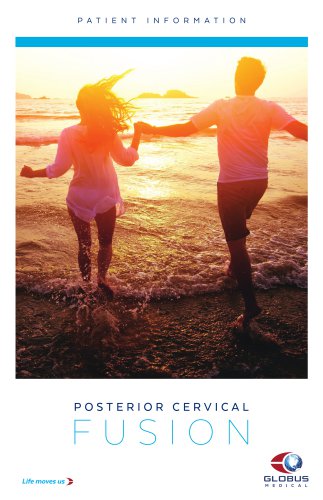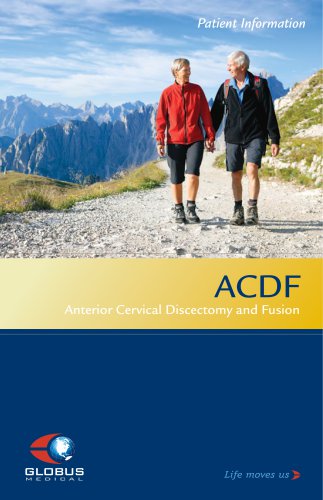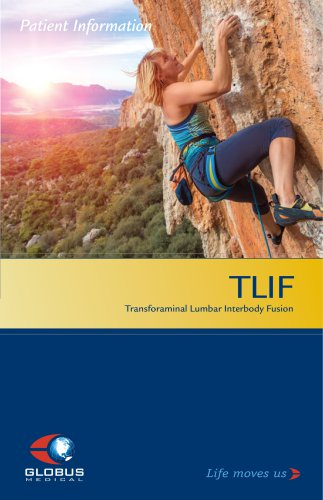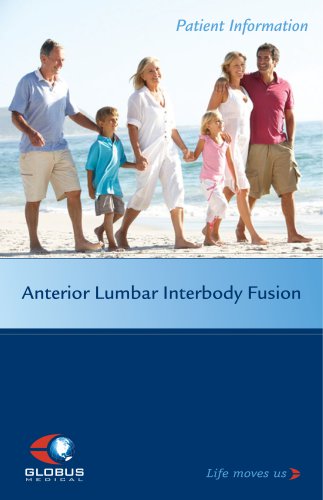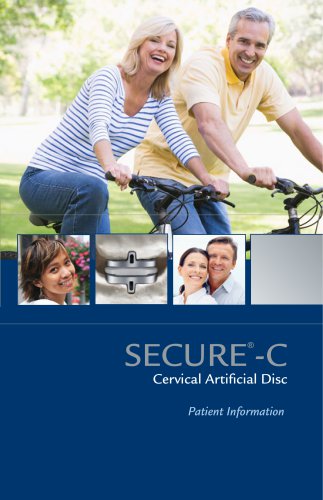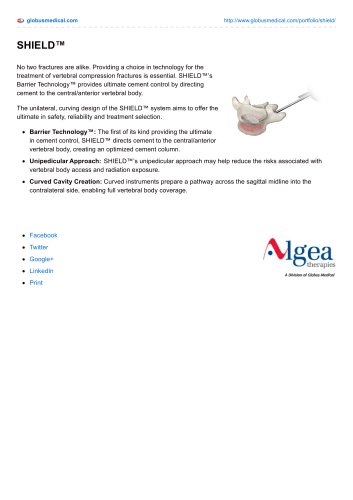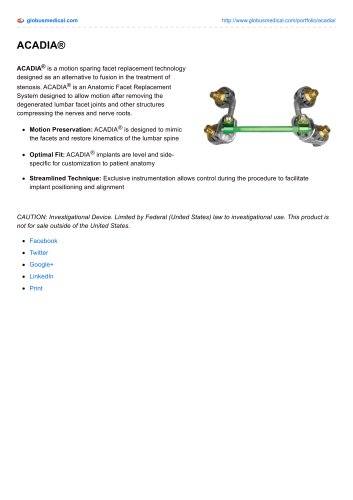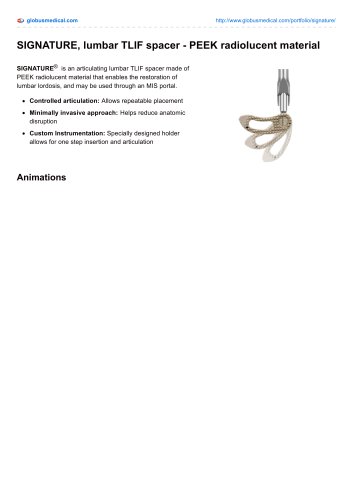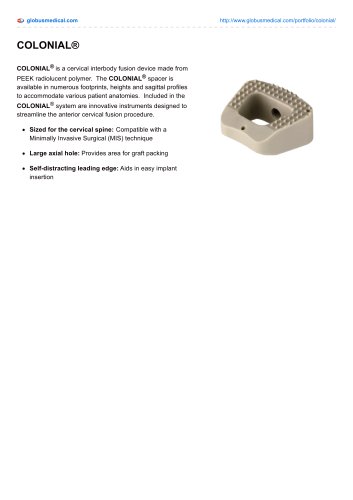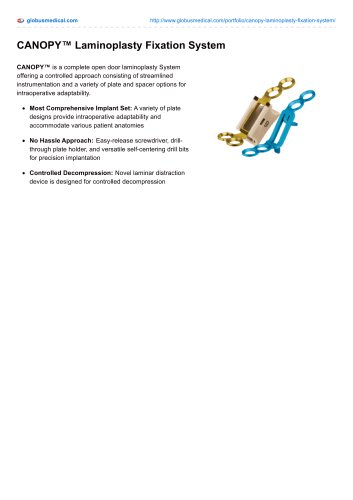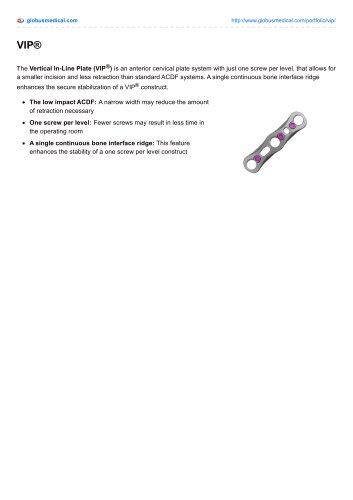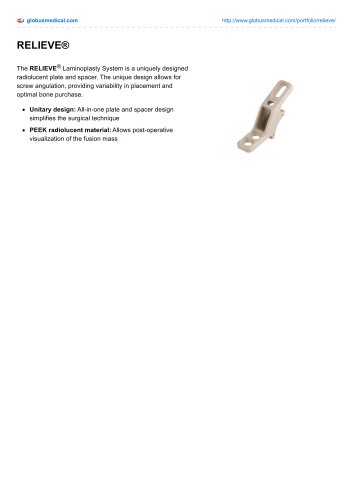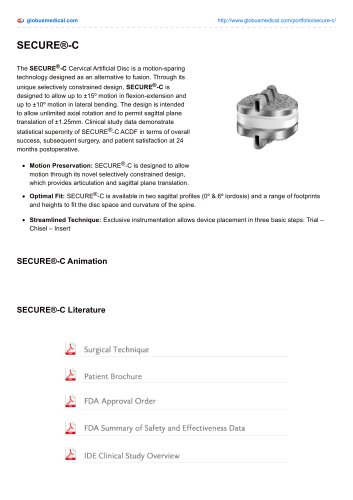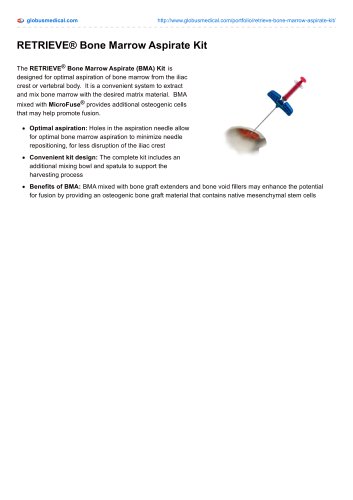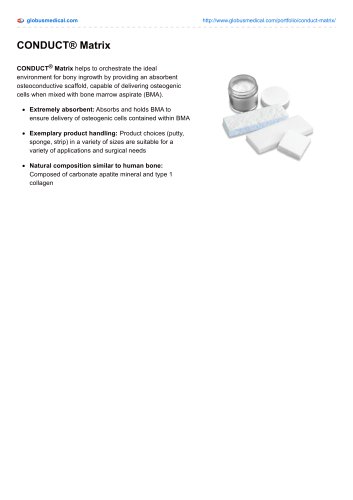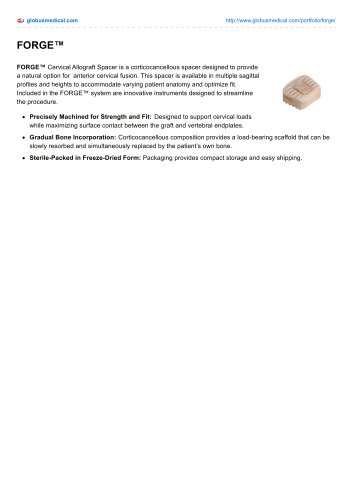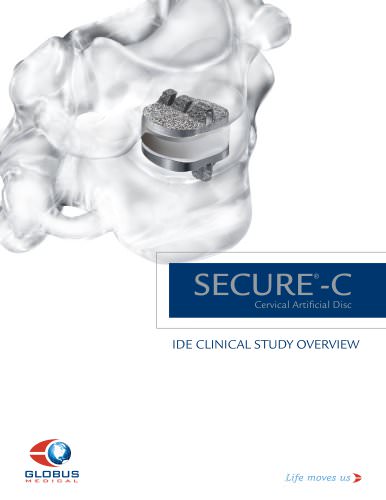 Website:
Globus Medical
Website:
Globus Medical
Catalog excerpts

Patient Information Lateral Lumbar Interbody Fusion Using Minimally Invasive Surgical Techniques
Open the catalog to page 1
Table of Contents Anatomy of Spine . . . . . . . . . . . . . . . . . . . . . . . . . . . . . . . . . . . . . . . . . . . . . . 2 General Conditions of the Spine. . . . . . . . . . . . . . . . . . . . . . . . . . . . . . . . . 4 What is Spondylolisthesis. . . . . . . . . . . . . . . . . . . . . . . . . . . . . . . . . . . . . . . . 5 What is Minimally Invasive Surgery? . . . . . . . . . . . . . . . . . . . . . . . . . . . . . 6 What is Fusion? . . . . . . . . . . . . . . . . . . . . . . . . . . . . . . . . . . . . . . . . . . . . . . . . 6 What is Lateral Lumbar Interbody Fusion?. . . . . ....
Open the catalog to page 2
Lateral Lumbar Interbody Fusion Using Minimally Invasive Surgical Techniques Patient Information This brochure will help you understand more about: • General conditions of the spine • Information about surgical treatment • MIS LLIF surgical technique • What to expect from surgery The decision to receive medical treatment is individualized to the patient and the patient’s symptoms. The information presented within this brochure may not apply to your condition, treatment or its outcome, as surgical techniques vary and complications can occur. It is important to discuss the viability of this...
Open the catalog to page 3
MIS LLIF Patient Information
Open the catalog to page 4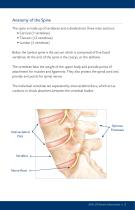
Anatomy of the Spine The spine is made up of vertebrae and is divided into three main sections: • Cervical (7 vertebrae) • Thoracic (12 vertebrae) • Lumbar (5 vertebrae) Below the lumbar spine is the sacrum which is comprised of five fused vertebrae. At the end of the spine is the coccyx, or the tailbone. The vertebrae bear the weight of the upper body and provide points of attachment for muscles and ligaments. They also protect the spinal cord and provide exit points for spinal nerves. The individual vertebrae are separated by intervertebral discs, which act as cushions or shock absorbers...
Open the catalog to page 5
General Conditions of the Lumbar Spine What is Degenerative Disc Disease? Degenerative changes in the spine may cause instability and pain in your back. Degenerative Disc Disease (DDD) involves the intervertebral disc and is part of the natural aging process. DDD can also result from torsional (twisting) injury to the lower back. In the normal spine, your discs act as a cushion between vertebrae. Over time the discs can lose flexibility, elasticity and height. When this happens, they lose their shock absorbing characteristics and can lead to abnormal motion or alignment of the spine, which...
Open the catalog to page 6
What is Spondylolisthesis? Spondylolisthesis is a condition in which one of the vertebrae slips forward or backward. If left untreated, this can lead to deformity of the spine and narrowing of the spinal canal. Typical symptoms include low back pain, muscle spasms, thigh or leg pain, and weakness. Interestingly, some patients are asymptomatic and only learn of the disorder after spinal radiographs. Normal spine segment Healthy Stable Level Unstable Level Displaced vertebra causing pressure on nerve MIS LLIF Patient Information
Open the catalog to page 7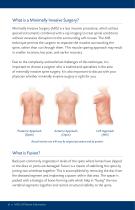
What is a Minimally Invasive Surgery? Minimally Invasive Surgery (MIS) is a less invasive procedure, which utilizes special instruments combined with x-ray imaging to treat spinal conditions without excessive disruption to the surrounding soft tissues. The MIS technique permits the surgeon to separate the muscles surrounding the spine, rather than cut through them. This muscle sparing approach may result in smaller incisions, less pain, and earlier recovery. Due to the complexity and technical challenges of this technique, it is important to choose a surgeon who is trained and specializes...
Open the catalog to page 8
What is Lateral Lumbar Interbody Fusion? Lateral Lumbar Interbody Fusion (LLIF) is a method of spine surgery in which the lumbar spine is approached through the patient's side. This procedure allows for dilation through the psoas muscle in a muscle splitting approach rather than approaching the spine anteriorly (through the abdomen) or posteriorly (through the back). Anterior (ALIF) and Posterior (PLIF/TLIF) approaches would require a larger incision with more muscle, bone and ligament disruption. Through the use of x-ray imaging, the LLIF technique permits the surgeon to separate and...
Open the catalog to page 9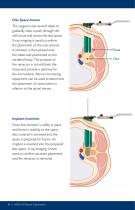
Disc Space Access The surgeon uses several tubes to gradually clear a path through the soft tissue and access the disc space. X-ray imaging is used to confirm the placement of the instruments. A retractor is then placed over the tubes and positioned on the vertebral body. The purpose of the retractor is to hold back the tissue and provide a pathway for the instruments. Nerve monitoring equipment can be used to determine the placement of instruments in relation to the spinal nerves. Implant Insertion Once the retractor is safely in place and there is visibility to the spine, disc material is...
Open the catalog to page 10
Pedicle Screws and Rods With the goal of minimally invasive surgery in mind, pedicle screws and rods are used to stabilize the spine. X-ray imaging may be used to determine the precise screw location. The screws are inserted into the spine and a rod is secured. Bone graft may be added along the side of the vertebrae. The surgeon will then close the incision and move the patient into recovery. MIS LLIF Patient Information
Open the catalog to page 11
What Should Patients Expect During Recovery? Patients may notice improvement of some or all symptoms and pain from surgery may diminish between two to four weeks after surgery. However, recovery time varies between patients. It is the surgeon’s goal for the patient to return to your normal activities as soon as possible. A positive attitude, reasonable expectations and compliance with post-surgery instructions all help to contribute to a satisfactory outcome. Due to the complexity of this technique, training is required and as with any surgical procedure, complications may occur. Such...
Open the catalog to page 12
Contraindications, Complications, Warnings, and Precautions You may be contraindicated for this procedure if you have an infection, a congenital abnormality, are obese, pregnant, mentally ill, diabetic, suffer from rheumatoid arthritis, osteoporosis, or cancer. As with any surgical procedure, complications may occur following the placement of this device. These can include but are not limited to early or late implant bending, breakage, failure, loosening, movement/migration, bone fracture, and allergic reaction to implant material. Other general complications associated with any spinal...
Open the catalog to page 13All Globus Medical catalogs and technical brochures
-
Discover the SHIELD™ VCF System
20 Pages
-
POSTERIOR CERVICAL FUSION
12 Pages
-
ExcelsiusGPS
12 Pages
-
CERVICAL LAMINOPLASTY
14 Pages
-
Discover the AFFIRM™ VCF System
20 Pages
-
SECURE-C®
24 Pages
-
ACDF
16 Pages
-
TLIF patient brochure
12 Pages
-
SI-LOK™
12 Pages
-
TRANSITION
12 Pages
-
complete bone graft
1 Pages
-
SP-Fix
12 Pages
-
SECURE®-C
24 Pages
-
Adolescent Idiopathic Scoliosis
16 Pages
-
ADULT SCOLIOSIS
16 Pages
-
MIS TLIF
12 Pages
-
MONUMENT
2 Pages
-
CREO AMP® Threaded
1 Pages
-
CREO MCS?
2 Pages
-
SHIELD?
1 Pages
-
ACADIA®
1 Pages
-
SIGNATURE®
1 Pages
-
SUSTAIN® & SUSTAIN®-R, Arch
1 Pages
-
TRUSS®
1 Pages
-
XPand®-R
1 Pages
-
ZYFUSE®
1 Pages
-
COLONIAL®
1 Pages
-
VIP®
1 Pages
-
PROVIDENCE?
1 Pages
-
RELIEVE®
1 Pages
-
ASSURE®
1 Pages
-
SECURE®-C
2 Pages
-
COALITION®
1 Pages
-
CAPITOL?
1 Pages
-
LATIS
3 Pages
-
CONDUCT® Matrix
1 Pages
-
FORGE?
1 Pages
-
SECURE®-C technical overview
12 Pages




